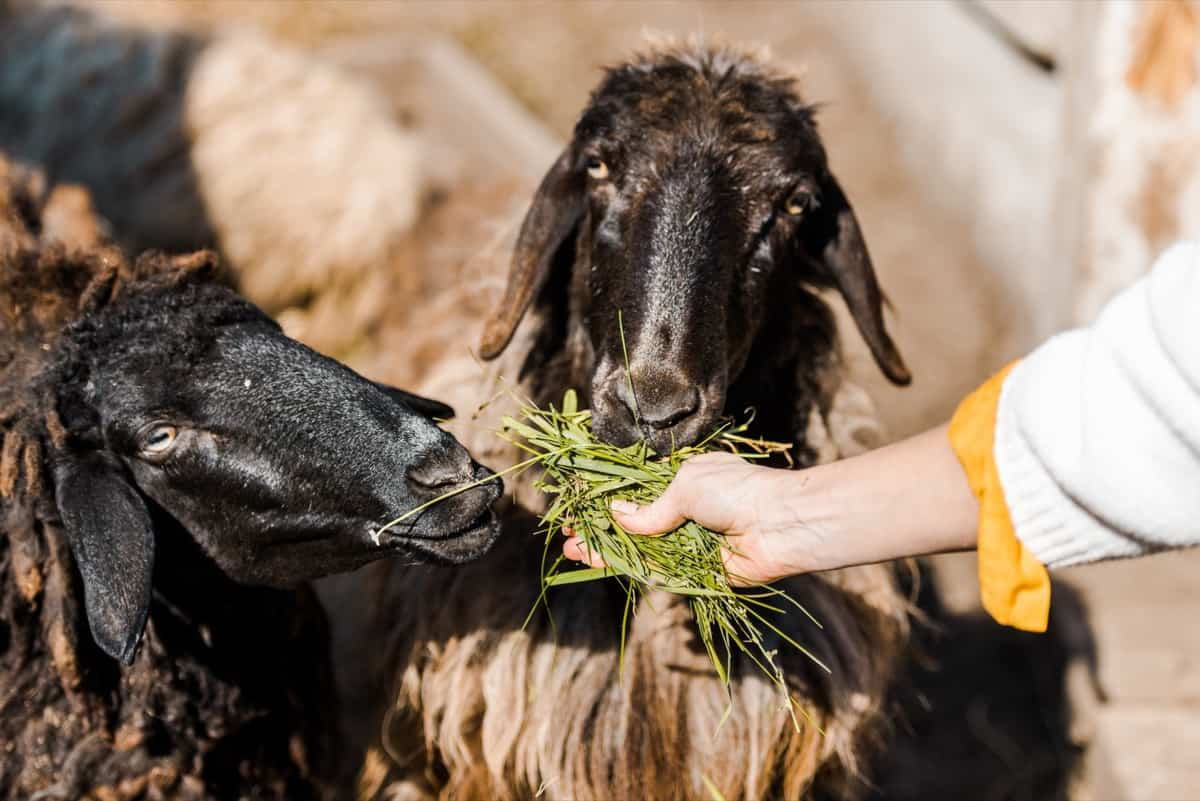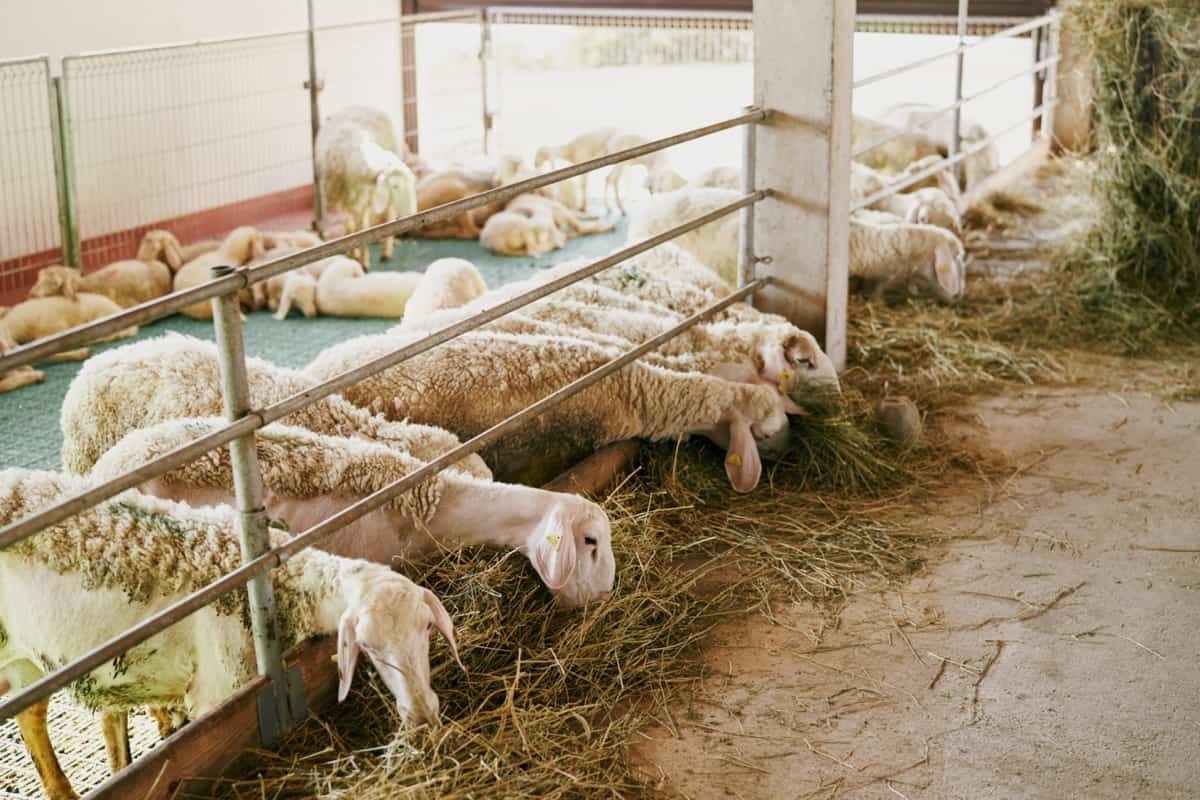Sheep are excellent at converting grass into meat, require high buildings to house them, and require less labor than other livestock. Sheep can thrive on natural grasses and do not require supplemental feed except during certain physiological phases. As a class of livestock, sheep are unsurpassed in their ability to utilize wastelands and weeds.

No domestic or wild animals can survive on a wider variety of food. It survives on weeds, grasses, shrubs, roots, cereals, leaves, bark, and, at times, fish and meat when food is scarce. Different aspects of feeding sheep at different physiological stages of their lives are discussed in this article.
Feed Management in Sheep
Feeding Flushing Ewes
The act of improving the nutritional status of ewes during 3-4 weeks before mating is called ‘flushing.’ Nutrition and body condition are important before putting the ewes to ram. When nutritional availability is declining, flushing will only affect ewes. Better-conditioned ewes will produce more lambs. Therefore, flushing leaner ewes increase fertility by increasing oestrus incidence and ovulation rates.
Suggested Feeding for Flushing Ewes
- A well-mixed pasture of legumes and grasses
- A grass pasture along with 150 grams of wheat bran per head per day.
- Grass pasture plus 250 grams of grains and 450 grams of oil cakes.
- Legume hay full-fed with 100 g of wheat bran and 150 to 200 grams of grain.
- Green fodder at the rate of 10% of body weight and 150-200 grams of concentrate per head per day
Pregnant Ewes
The fetus makes up two-thirds of its total growth during the last six weeks of pregnancy. The consequences of undernutrition in late pregnancy are a reduction in lamb’s birth weight, poor milk production, and poor lamb survival. Nutrients, especially energy, must be increased in pregnancy to ensure proper fetus growth and high milk production.
Feeding Ewes During Early and Mid-pregnancy
- Grazing: On a good pasture.
- Sorghum silage: Per head, one to two kg of legume hay and one to two kg of sorghum silage are recommended
- Daily provision of maize or sorghum fodder plus 50 grams of oil cakes, such as groundnut cake, per head
- In addition to grazing on stubbles and harvested fields, each head of cattle receives 100 grams of oil cake daily.
In case you missed it: 45 Days Chicken Business Plan: A Poultry Guide for Beginners

Feeding Ewes During Late Pregnancy
- During this period, ewes may graze on crop residue (crop stubble), wild grasses, or weeds.
- Green fodder should be fed at a rate of 5 kg per head per day to supplement their ration.
- You may feed 225 grams of molasses or grains per head per day (barley, maize, oats, etc.).
- Moreover, green fodder should be provided to the ewes each day at a rate of 7 kg per head
- Alternatively, 300 grams of concentrate or 600 grams of quality legume hay may be used.
Feeding Lactating Ewes
During lactation, energy and protein requirements are higher. Therefore, lactating females need a lot of grazing, and supplementary concentrate, legume hay, or dry tree leaves to meet their energy requirements. When sheep are lactating, a high-protein diet improves milk yield, but at the expense of their reserves; as a result, both energy and protein should be balanced in their diet.
- If they are provided with good pasture, their requirements are met more or less. The amount of additional feed can be calculated as follows when supplementary feeding is necessary:
- A ewe can replace 50 percent of her daily pasture requirement with good hay, silage, or grain by consuming 450 grams daily.
- If cultivated green fodder is fed, 10 kg per head is sufficient, or 400 grams of concentrate mixture or 800 grams of quality legume hay daily for 75 days after lambing, on top of 8 hours of grazing per day.
Colostrum Feeding of Lambs
A lamb should get a sufficient amount of colostrum (first milk) from the mother during the first few days after birth. It imparts passive immunity through gamma-globulins in which colostrum is very rich, against several infectious diseases against which the mother has been vaccinated or has more recently been exposed.
- To get a good amount of colostrum, the lamb should be allowed to suckle its dam for three or four days after birth.
- Feeding colostrum is an important factor in limiting kid losses. The colostrum from cows is also effective for lambs.
- Each kg of live weight requires 100 ml of colostrum.
- The preservation of colostrum can be accomplished by adding 0.1% formaldehyde or 1-1.59% propionic acid (volume/weight). Because propionic acid maintains a low pH value, it is preferred for preservation.
Pasture Management for Sheep Farming
Sheep generally thrive well on pasture. Therefore, attention should be paid to pasture improvement and management. Rotational grazing should be followed to avoid worm infection and unthriftiness and ensure the availability of good pasture. The fodder should be conserved in hay and silage for the lean period. Fodder trees should be planted in the pasture to provide shade and fodder during the lean period to the grazing flocks.
In case you missed it: Feed Management in Goat Farming: Feeding Plan, Feed Formula, and Fodder Requirements

Water Management in Sheep Farms
The water requirement of sheep varies depending on their physiological status and ambient temperature in different seasons. The sheep should be watered at least once a day at the rate of 2-3 liters per head per day. The water requirement for crossbreds during summer months will be slightly higher and may range between 5-6 liters.
The younger ones may require 1-2 liters of water every day. Sheep breeds in arid regions adapt well to water restrictions for up to 48 hrs. Watering should be done in metallic troughs or cemented channels. The flock should be weighed at least once a week to at least 10% before being turned out for grazing. This work may be distributed over the week.
Conclusion
Feeding, husbandry practices, and health care are essential to sheep’s economic and efficient production of meat, wool, show, and pets. As sheep are kept under various environmental conditions, their nutritional requirements for maintenance, reproduction, growth, finishing, and wool production are complex. However, it is important to ensure that each production unit or individual sheep receives enough nutrients to remain healthy and productive.
- Feed Your Flock for Less: Top 10 Tips to Save on Chicken Feed
- Ultimate Guide to Ossabaw Island Hog: Breeding, Raising, Diet, and Care
- Hatching Answers: The Top 10 Reasons Your Chickens Aren’t Laying Eggs
- Eggs and Economics: Breaking Down the Cost of Raising Backyard Chickens
- Defend Your Greens: Proven Methods to Keep Iguanas Out of Your Garden
- Ultimate Guide to Cinnamon Queen Chicken: A Comprehensive Guide for Beginners
- Ultimate Guide to California Tan Chicken: Breeding, Raising, Diet, Egg-Production and Care
- Ultimate Guide to Marsh Daisy Chicken: Breeding, Raising, Diet, and Care
- 10 Types of Chicken Farming Businesses You Can Start for Profits
Appreciate